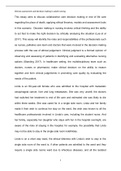Clinical assessment and decision making in adult nursing
This essay aims to discuss collaborative care decision making in end of life care
regarding the place of death, applying ethical theories, models and assessment tools
in this scenario. Decision making in nursing involves critical thinking and the ability
to act fast to make the right decision by critically analysing the situation (Lee et al
2017). This essay will identify the roles and responsibilities of the professionals such
as nurses, palliative care team and doctors that were involved in the decision-making
process with the use of ethical judgement. Clinical judgment is a formed opinion of
observing and assessing of patients in identifying and evaluating alternative nursing
options (Standing 2017). In healthcare setting, the multidisciplinary team such as
doctors, nurses or pharmacist, make clinical decision on the ability to reason
together and form clinical judgements in promoting care quality by evaluating the
needs of the patient.
Linda is an 80-year-old female who was admitted to the hospital with metastatic
oesophageal cancer, liver and lung metastases. She was very unwell; the doctors
had switched her treatment to end of life care and estimated she was likely to die
within three weeks. She was cared for in a single side room, Linda and her family
made it their wish to continue her stay on the ward, the wish was known to all the
healthcare professionals involved in Linda’s care, including the student nurse. And
her family, especially her daughter who stays with her in the hospital overnight, are
aware of the risks of staying in the hospital, for example, the possibility that Linda
may not be able to stay in the single side room indefinitely.
Linda is on a short stay ward, the ethical dilemma with Linda’s wish to stay in the
single side room of the ward is, if other patients are admitted to the ward and they
require a single side rooms ward due to infectious diseases, and all the isolated
1
,Clinical assessment and decision making in adult nursing
rooms are occupied with other infectious patients they will be requesting to move
Linda to another non-isolated room on the ward or a different ward altogether. While
making this choice, Linda was assessed and was found to have full mental capacity;
however, due to being seriously unwell, Linda may be making a sensitive request
that she would not have done if she was physically well.
Decision making about the end of life places of care is very important to the patient
and family. End-of-life (EOL) care is the care for people who are in their last few
weeks or months with a rapid deterioration of advanced disease before death (Mistry
et al, 2015). de Boer et al. (2017) highlighted dying patients may choose to die in
palliative care units or hospices or at home, in a hospital, in residential and nursing
care home, but a good quality palliative care is dying in a preferred setting. Mistry et
al. (2015) suggest what matter most in end of life care is supporting the desire of
patients to die the way they want, Linda has chosen to die in the hospital, and her
family had supported her decision. Nevertheless, most people have died in the
hospital but it is not always their choice to die in the hospital (Department of health,
DH 2008). Redley et al. (2011) proposed Mental Capacity Act 2005 is in place for
both people who can and cannot make an autonomous decision. de Boer et al.
(2017) found the quality of palliative care is highest when the patient had died at
home or in a hospice compared to a hospital. However, this study took place in
Netherlands and maybe other countries might produce different results but the
authors suggest it is unlikely for different result to be produced.
Mental Capacity Act (MCA) 2005 is the framework used by healthcare professionals
to assess the mental capacity of the people in their care. The MCA (2005) states
everyone must be assumed to have capacity in making decisions, if a person has not
2
, Clinical assessment and decision making in adult nursing
been assessed to lack capacity, they must not be treated as incapable of making
decisions even when such person makes unwise decisions (Department of
Constitution Affairs, 2007). The Act places the patient at the centre of their care,
allowing the patient to express his or her feelings and wishes in their treatment and
care (Harris and Fineberg, 2011). For example, Linda was assessed to have
capacity in making decisions, she was sure she wanted to be cared for in the single
side room on the ward until her death, so she expressing her wish to the staff, and it
was documented in her notes.
Redley et al. (2011) suggest decision-making capacity may be impaired due to
hospital environments having an impact on the psychological state. Marhsall and
Sprung 2016 argued that even though MCA, 2005 is a legislative act to empower the
patient and healthcare professional staff, it is not being used to its maximum
potential due to lack confidence, experiences, or knowledge of healthcare
professionals. A competent patient has the right to be involved in decisions relating
to their care or treatment (DH, 2009). Healthcare professionals apply MCA (2005) to
preserving patient autonomy, for those who are able and unable to make decisions
concerning their care.
No decision about me without me allows the patient to be involved in decision
relating to their disease and treatments, knowledgeable to understand the benefits
and risks make informed decisions (King’s Fund 2011). DH, (2009) highlight the
importance of patients before consenting to any treatments, the patient needs
information to educate themselves about the treatment, then the patient can make
an informed, rational decision to go ahead with the treatment or not. Dimond (2009)
stated that for consent to be considered as valid, the patient must give it freely,
3




